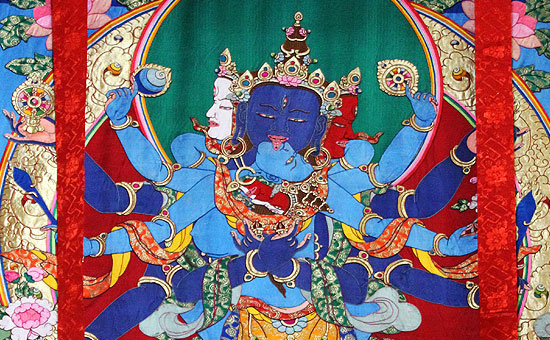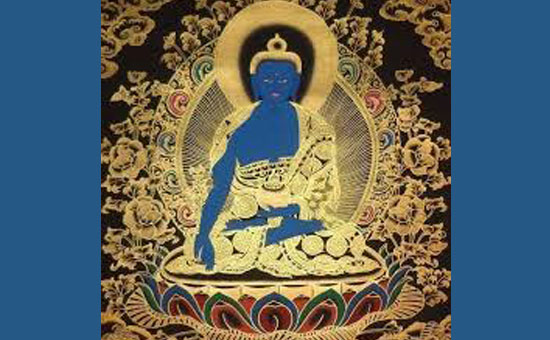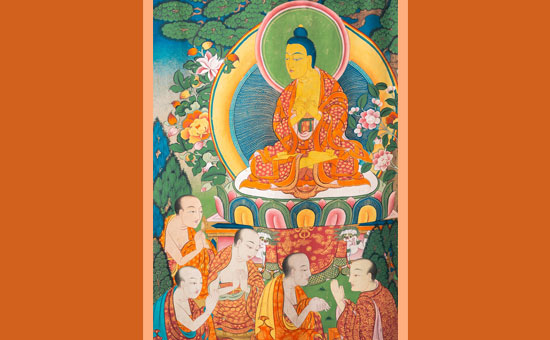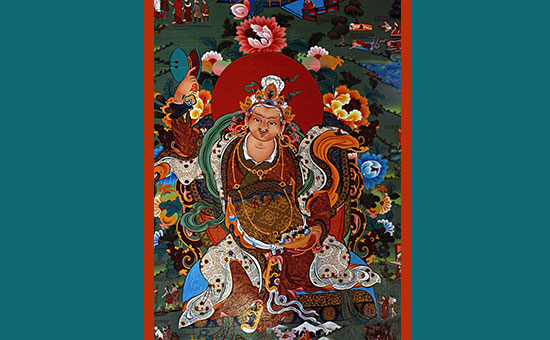- Article tells about the origins of Thangka paintings, types of paintings, favourite Gods depicted in Thangka, painting process, guidelines for aspiring artists and spiritual connection of Thangka paintings.
The
Origins of the Thangka
The
Tibetan Thangka is an art form that originated in Nepal, and was brought to
Tibet by Nepalese princess, Bhrikuti, who was the wife of Sonsgtsen Gampo,
the founder of the Tibetan Empire. The paintings were developed over the
centuries from the early wall murals that can be seen in a few remaining sites
like the Ajanta Caves in India and the Mogao Caves in Gansu Province, Tibet.

The
Mogao Caves have extensive wall paintings, and were previously a repository for
many Tibetan paintings on cloth, which are some of the earliest surviving
Thangka, as well as other manuscripts, paintings and prints. The earliest dated
prints from the “Library Cave” were dated to be from around 780-848 AD, when
the region was under Tibetan rule.
Traditionally,
the Thangka are designed to tell the life of
Buddha, as well as other influential lamas and deities. The Tibetan word
THANG KA means “recorded message” in English.
The
composition of the Thangka is very complex and elaborate, and often
incorporates the central figure - normally a deity - surrounded by many smaller
figures, in a symmetrical design.
Although
they are less common, narrative scenes are also depicted on Thangkas. Thangka
are also used as devotional pieces during religious rituals or ceremonies, and
can be used as a medium for prayer.
Moreover,
Thangkas can aid in the spiritual path to
enlightenment as the religious art is used as a meditation tool.
Devotees often have Thangka paintings hung in their homes, bedrooms and
offices.
Types of paintings
In
Tibet, religious paintings come in several forms, including wall
paintings, thangkas (sacred pictures that can be rolled up), and
miniatures for ritual purposes or for placement in household shrines.
Some
thangka artists travelled all over Tibet, working for monasteries as well as
for private patrons. Thangkas were
commissioned for many purposes - as aids to meditation, as requests for
long life, as tokens of thanksgiving for having recovered from illness, or in
order to accumulate merit.
Those
who commissioned thangkas also supplied the materials, so their
financial status determined the quality of the pigments, the amount of gold
used for embellishment, and the richness of the brocade on which the painting
was mounted.
Thangkas could be woven, embroidered, or appliquéd.

Special Thangkas
And
at the Shoton Festival, one of the most popular of Tibet’s traditional
festivals, the Thangka is unveiled at the Drepung Monastery in Lhasa.
As
the sound of the horn echoes through the valley, a host of lamas carry the huge
portrait of Qamba Buddha from the Coqen Hall and towards the western end of the
monastery to a specially erected platform. As smoke rises from all sides and
monks chant scriptures, the lamas slowly unroll the Thangka to cheers from the
crowds, who rush to the painting to offer their white hada, or prayer silks.
This Thangka is only open for around two hours, before the monks move it
carefully back inside for another year.
Favourite gods
Peaceful
deities, wrathful deities, and mandalas are among the subjects depicted
in thangkas. Each Tibetan Buddhist sect has its favorite gods; therefore,
identifying a particular god depicted on a thangka helps determine the sect
with which the painting is associated. For example, a blue image of the Buddha
Samantabhadra situated at the top center of a thangka associates that
painting with the Nyingma order, and paintings made for the Gelug order usually
include a figure of TsongKhapa.
Thangkas
are fragile objects; they fade when exposed to light. The Asian Art Museum’s
policy is to preserve these objects by displaying them in low light and by
rotating the collection; happily, this will allow visitors to see a new group
of thangkas about every six months.

Painting Process
Traditionally,
thangka paintings are not only valued for their aesthetic beauty, but primarily
for their use as aids in meditational practices. Practitioners use
thangkas to develop a clear visualization of a particular deity,
strengthening their concentration, and forging a link between themselves
and the deity.
Historically,
thangkas were also used as teaching tools to convey the lives of various
masters. A teacher or lama would travel around giving talks on
dharma, carrying with him large thangka scrolls to illustrate
his stories.
The
deities shown in thangka paintings are usually depictions of visions
that appeared to great spiritual masters at moments of
realization, which were then recorded and incorporated into Buddhist
scripture.
The
proportions are considered sacred as not only are they
exact representations of Buddhist deities, but also the visual expression
of spiritual realizations that occurred at the time of a vision.
Thangka
painting is thus a two-dimensional medium illustrating a multi-dimensional
spiritual reality. Practitioners use thangkas as a sort of road map to
guide them to the original insight of the master. This map must be accurate. Hence,
it is the sole responsibility of the artist to make sure that the Thangka
Painting is considered genuine and guides one and all to the proper and
peaceful place.
Because
thangkas are not the product of an artist’s imagination, but are as carefully
executed as a blueprint drawing, the role of the artist is somewhat different
than the inventor we know him to be in the West. The role of the artist becomes
one of a medium or channel, who rises above his own mundane consciousness to
bring a higher truth into this world. In order to ensure that this truth
remains intact, he must diligently adhere to all the correct guidelines.

Guidelines for Aspiring Artists
Aspiring
thangka artists must spend years studying the iconongraphic grids and
proportions of different deities and then master the technique of mixing and
applying mineral pigments.
Norbulingka
Institute in Dharamshala, Himachal Pradesh offers a three-year training program
for Tibetan students. After completing their three year course, most artists
then join their workshops, where they must complete an additional three years
as apprentices before they are considered fully qualified artists.
To
make a thangka, first a piece of canvas is stitched onto a wooden frame. It
is prepared with a mixture of chalk, gesso, and base pigment, and rubbed
smooth with a glass until the texture of the cloth is no longer
apparent.
The
outline of the deity is sketched in pencil onto the canvas using
iconograpic grids, and then outlined in black ink. Powders composed of crushed
mineral and vegetable pigments are mixed with water and adhesive to create
paint. Some of the elements used are quite precious, such as lapis lazuli for
dark blue. Landscape elements are blocked in and shading is applied using both
wet and dry brush techniques. Finally, a pure gold paint is added, and the
thangka is framed in a precious brocade boarder.
A
standard thangka painting in Norbulingka, which is about 18 x 12 inches,
takes an artist about six weeks to complete.
These days, it is becoming more and more rare to find genuine thangkas because
of the length of time it takes to learn the skill and create a painting
properly. However, Norbulingka is committed to preserving the skill of thangka
painting in the traditional form.
Some
more institutes in India which offer courses are -
1. Thangde
Gatsal Art Studio and School, Dharamshala, Himachal Pradesh.
2. Institute
of Tibetan Thangka Art Dharamshala, Himachal Pradesh.
3. Living
Buddhist Art & Thangka Painting Center Dharamshala, Himachal Pradesh.
4. Buddha
Thangka Art Gallery, Rishikesh, Uttarakhand.

Spiritual Connection
Aside
from being an aid to spiritual practice, commissioning a thangka is considered
a means of generating spiritual merit, and many times, if an individual is
facing some kind of hardship, a lama is consulted and recommends the creation
of a thangka of a specific deity as a remedy. The artist then designs a thangka
by referring to the measurements of deities detailed in the scriptures,
following the prescription of the lama.
Creating
these one-of-a-kind thangkas requires extensive research, especially as the
descriptions explaining the proportions of each deity are not compiled in one
text, but are located in different volumes throughout the hundreds of volumes
of Buddhist scripture. Furthermore, some texts cannot even be touched unless
one has received the proper initiation for that specific deity.
Because
the art is explicitly traditional, all symbols and allusions must be in
accordance with strict guidelines laid out in the Buddhist scripture. The
artist must be properly trained and have sufficient religious understanding,
knowledge, and background to create an accurate painting.

Conservation
The conservation treatment of a thangka is a complex process that reflects the
complexity of the original composite object. All of the issues raised above
must be evaluated in deciding on the appropriate treatment for a specific
thangka.
For example, a Conservator must look carefully for any exposed colour notations
and not confuse them with iconographic lettering on the final paint layers. A
Conservator must evaluate what regional and stylistic techniques were used in
producing the painting and mounting and also look for damage from past
handling. And finally, the Conservator must examine the current mounting to
determine its relation to the painting and document whether it covers
significant sections of the painting.
Conclusion
Thangkas
are complicated composite objects which are designed to communicate
iconographic ideas in a beautiful and practical form. A thangka in laboratory
or collection may be the production of many painters and tailors with differing
intents, and differing skills and training. The textile mounting may have a
completely different style, date and region of origin from those of the
painting.
Pure,
single artistic intent is lost through a combination of iconographic
specifications, regional and doctrinal differences in style, changes in form
subsequent to the original creation and many years of harsh treatment.
Author is a Mumbai based artist.
The
purpose of this compilation is to document and promote. We have given credits
and reference links in this compilation. In case some are missed, it is not
with malafide intent.
To read all
articles by author